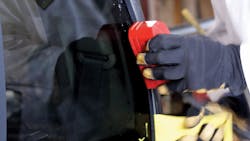Steps to building a bulletproof glass repair plan
This is part one of a two part article.
A tiny windshield chip or crack might not seem like a big deal on a rough-and-tumble commercial vehicle, but these issues can spread if not resolved in a timely manner. Driving with a damaged windshield is not only unsafe, but oftentimes illegal.
As with any vehicle repair, even the smallest oversight can fracture into a host of new problems if not done right the first time. That never needs to be an issue if a fleet develops a sound glass repair strategy and sticks to it. Fleet Maintenance spoke with several glass repair experts to find out what that gameplan should look like.
1. Decide if the damaged area requires replacement or repair
The decision to repair or replace generally comes down to four elements:
- Regulatory requirements
- Driver vision
- Structural integrity of the glass
- Cost and downtime for the fleet
U.S. Department of Transportation regulations state that a windshield cannot have damage in what is essentially a driver’s primary viewing area. That said, there are a couple of exceptions: when a crack isn’t intersected by other cracks; and when the damaged area is no closer than 3 inches to any similarly damaged area and can be covered by a 3/4-inch-diameter disc. However, it’s important for fleets to understand that some states have more stringent regulations.
Read more: To keep truck bodies cleaner this summer, build a bug out bag
“Some states require a windshield to be replaced any time damage is on the driver’s side within that primary viewing area,” said Thomas Patterson, director of new product development and technical training for Glass Doctor, a Neighborly Company, which specializes in glass repair and replacement services. “We as a company do not condone doing a stone chip repair in that primary viewing area. That’s where we would simply recommend replacement.”
What is the driver’s primary viewing area? Based on the Repair of Laminated Auto Glass Standard (ROLAGS), it is 12 inches centered off of the steering wheel and 12 inches wide in the path of the wiper.
Glass Doctor also doesn’t like to attempt repairs in the vicinity of any windshield wiper heater grids that might be on the vehicle. “That creates a hot spot, which we never want to do,” Patterson added.
For windshield damage that is outside of those sensitive areas, there are instances where chips and cracks can be repaired, helping a fleet reduce both downtime and repair cost. This is also true of similar types of damage to back glass and vehicle door windows.
“Now it comes down to the type and size of the break,” Patterson said, adding that there are a few key damage classifications a glass technician needs to look for.
A “bullseye” looks like the glass was shot by a BB gun, but there are no visible legs or cracks protruding out.
“A good glass technician can repair this type of damage up to an inch in diameter,” Patterson said.
A “star break” does have three or four cracks emanating from the point of impact. “As big as you can safely go is around 2 inches,” Patterson said. “Anything beyond that starts affecting the integrity of the glass.”
A “combination break” is another form of damage. This is essentially a star break on top of a bullseye. “Again, anything 2 inches or smaller can usually be repaired without much problem,” Patterson said.
According to Patterson, one of the biggest misconceptions is that a stone chip repair is an aesthetic repair. In reality, the purpose of the repair is to maintain the structural integrity of the glass.
“When the repair is completed, it might not look any different, and sometimes it might look a thousand times better and almost disappear,” Patterson pointed out.
2a. Make the repair
To properly perform a stone chip repair, there are different types of tools and resins available. Regardless of which specific products are utilized, the process should always follow a proven blueprint.
“The first thing you want to do is create a vacuum to extract any air or moisture out of the break (using a specialized tool that works like a syringe plunger),” Patterson said. Trapped air or moisture is the dark color you can see in a break. Once that air or moisture is vacuumed out, it’s time to introduce a liquid resin that bonds the glass back together.
“Once the resin is suspended in that vacuum and you open the chamber up, the vacuum pulls the resin into the break to fill the void,” Patterson said.
Introducing the bonding resin is a relatively straightforward process, but sometimes the technician needs a little assistance. For example, the tiny cracks in a star break may radiate out a bit further than the vacuum can draw.
“Then the technician has to flex the glass to open up the break,” Patterson explained.
Glass Doctor technicians use a steel probe to push down on the center of the crack. That opens up the inside of the break so the resin can flow in from underneath and fill the crack all the way to the end of the fingers.
Once the technician feels good with the repair, the UV curing process can begin. Each resin is matched with a specific range of the light spectrum for curing.
Read more: FMCSA makes windshield-mounted video cameras permanent
“The technician puts on their UV lamp to cure the resin, which essentially freezes everything in place,” Patterson said. The curing process generally takes just a few minutes.
“Then the technician is left with the pit where the glass was removed from the break,” Patterson continued. “Our technicians use a pit filler, which is a more viscous and dense resin, to fill that pit. They apply that resin and put a piece of polyvinyl on top to hold it in place, and then cure it with their UV light. Once that’s cured, they just remove the polyvinyl piece, scrape the filler down so it’s flush with the glass, and buff it until it’s shiny like the rest of the glass.”
2b. Make the replacement
As mentioned earlier, there are instances when a windshield cannot be repaired and must be replaced. There are different ways a technician can go about removing a windshield or other panels of glass. Cutting it out with a knife is arguably the most common.
There are also specialized tools a glass technician could use. Equalizer is one manufacturer that offers these types of tools. Equalizer’s product offering includes tools designed to help separate lower corners of windshields when a knife won’t work, battery-powered bladed tools to enhance the cutting-out process, and cord-and-wire devices.
Patterson said many in the auto glass repair industry have reverted back to an old-school methodology—but with a little twist, literally.
“When I started out in this industry more than 40 years ago, we used piano wire,” Patterson said. “Now we’re using what is essentially a braided cloth string. The technician feeds it through and uses a ratcheting-type device to cut out the glass.
“We like this method for several reasons,” Patterson continued. “Many of today’s vehicles have aluminum and/or really thin pieces of metal. Traditional tools have a decent chance of damaging those types of materials. You have to treat the replacement differently than when working with steel.”
A glass technician could also use an induction heating device to help remove windshields and other panels of glass. The Inductor Glass Blaster from Induction Innovations is one example.
“The science behind this tool is pretty simple,” said Cliff Lu, sales and marketing specialist for Induction Innovations. “The technician uses the Glass Blaster to heat up the pinch weld while applying constant outward pressure with an I-wedge. That allows the technician to release the urethane line at its lowest possible temperature, helping to avoid any collateral damage to the vehicle.”
According to Lu, using the Glass Blaster is straightforward for a skilled technician. Removing a windshield involves a five-step process that generally takes around 15 to 30 minutes on a large vehicle like a semi-truck. That’s a considerable time saving over the traditional method of using knives or wires, which Lu said can sometimes take a couple of hours.
As Patterson also pointed out earlier, protecting the area around the repair is an important consideration for a glass technician. That’s why one of the five steps of the Glass Blaster process includes spraying cool water around the window to protect the paint from overheating and to guard against damaging any rubber. Lu said a technician could also use another product from Induction Innovations, Inductor Cold Shield Thermal Spray Gel, for an added degree of protection.
Click here for part two, which delves into what Advanced Driver Assistance Systems add to the glass repair process.
About the Author

Gregg Wartgow
Gregg Wartgow is a freelancer who Fleet Maintenance has relied upon for many years, writing about virtually any trucking topic. He lives in Brodhead, Wisconsin.

